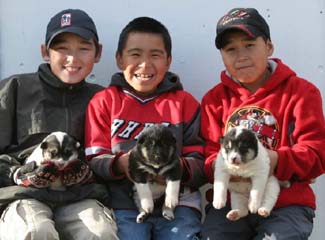In This Issue....
Featured Inuit Dog Owner: Sandy Hagan
Inuit Dog Thesis 15th Anniversary Edition
Product Review: Delivering the Goods
IMHO: A Few Thoughts about the Final Report on the Dog Slaughters
Navigating
This Site
Index of articles by subject
Index
of back issues by volume number
Search The
Fan Hitch
Articles
to download and print
Ordering
Ken MacRury's Thesis
Our
comprehensive list of resources
Talk
to The
Fan Hitch
The Fan
Hitch home page
ISDI
home page
Editor: Sue Hamilton
Webmaster: Mark Hamilton
The Fan Hitch welcomes your letters, stories, comments and suggestions. The editorial staff reserves the right to edit submissions used for publication.
Contents of The Fan Hitch are protected by international copyright laws. No photo, drawing or text may be reproduced in any form without written consent. Webmasters please note: written consent is necessary before linking this site to yours! Please forward requests to Sue Hamilton, 55 Town Line Rd., Harwinton, Connecticut 06791, USA or mail@thefanhitch.org.
This site is dedicated to the Inuit Dog as well as related Inuit culture and traditions. It is also home to The Fan Hitch, Journal of the Inuit Sled Dog.

Young ISD pups receiving early
socialization
Photo: Wittenborn
A Few Thoughts on the Final Report on the Dog Slaughters
by Mark Hamilton
I read the RCMP's September, 2005 interim report, so it came as no surprise to me when the review team's final account found no evidence of an "organized mass slaughter of Inuit Sled Dogs". Of course, that finding came with a few qualifiers: it applies only to the RCMP, directed by the government or on itís own initiative, between 1950 and 1970, in Nunavut and Nunavik.
The final report was submitted on November 29, 2006. The 26-page executive summary can be read here and the 771-page internal (full) report is available on a CD by writing to the RCMP.
I realize that just telling you I wasn't surprised isn't saying much. And this time I really don't want, or believe I should tell you everything that's on my mind. The 771-page report covers a lot of ground, touching on more issues than just the allegations of dogs wrongfully killed. Since I was not a party to, or witness of any of the alleged events, my opinion would just not be particularly useful to you. What everyone concerned needs to do is read these documents for him or herself and then draw their own conclusions.
I will say I was not at all pleased to see the Inuit Sled Dog identified as a large and dangerous predator, a hazard to health and safety. Words and sentences have been skillfully lifted from an assortment of documents and writings and assembled into what I view as a masterful mischaracterization. The ominous wording of the report reminds me of the wording we see in breed specific bans and regulations. And just as in the case of those breed specific bans and regulations, the principal criticism of this section of the RCMP report is that there is no justification for singling out the ISD. A starving or diseased Inuit Sled Dog is no more of a threat to humans than any other similar sized dog in fact, in the case of zoonotic diseases, such as rabies, a dog's size has nothing to do with seriousness of the threat.
Another example: First the report acknowledges multiple references to the necessity of early and intense socialization of Inuit Sled Dog puppies to humans (as a preface to their characterization of the dog as dangerous), but later in the report dismisses Inuit claims that it was not good for their dogs to be tethered on the basis that tethering didn't make southern dogs vicious.
From my reading of the executive summary and the internal report, I came to the conclusion that it was very important to the RCMP review team for the Inuit Sled Dog to be characterized as a large and dangerous predator. But in light of the ISD's record of partnership with the Inuit, a synergistic relationship spanning thousands of years that allowed the two to not only survive but also to thrive in the hostile climate of the arctic, I can only wonder at such a characterization.
The Arctic is harsh. It weeds out weakness. Strengths are identified and built upon. Once the snow melts, virtually overnight, the tundra is transformed with a coat of lush vegetation. Little plants that survived the extreme cold of the long arctic winter leap from the poor soil, bloom and spread their seeds in the time-compressed arctic spring/summer/fall. So too, animal life is shaped and tempered by the unyielding conditions of the Arctic. From polar bear to lemming, it's the same, meet the challenge or perish. It's a shame the RCMP report, after acknowledging the alliance between the Inuit and their dogs, fails to honor that, choosing instead to mischaracterize the dog.